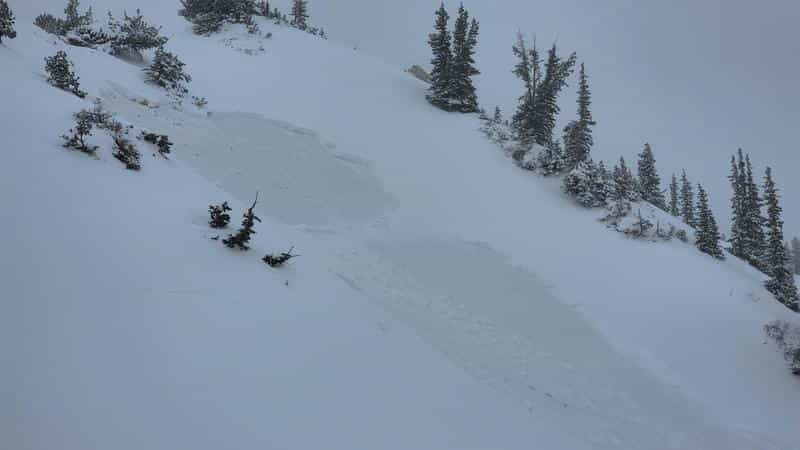
The Utah Avalanche Center has received its first skier-triggered avalanche reports of the season following a recent storm that deposited up to 19 inches of new snow in the backcountry. The avalanches, primarily composed of soft slabs of new snow or wind-drifted snow, were reported in upper elevation northerly facing terrain.
“Saw a group drop a similar aspect and decided to push up one more drainage. We jumped on the slope from the top. Ski cut the top with no reaction before riding. Rider went saw wind slab triggered and immediately exited with speed to established safe exit that was talked about before in case anything went. It was almost a delay but stepped down into the PWL. This part connected to the ridge on the right and across into the secondary gully about 200 yards across and I’d say 18-20 inches deep.”
Three separate slides were reported on Sunday, November 19, 2023. One on Deseret Peak was triggered by a skier and was 7″ deep and 15′ wide; a second was triggered by a skier at Rocky Point and was 12″ deep and 50′ wide, and a third was triggered on Rocky Point again, by a snowboarder, and was 18″ deep and 200′ wide.
“Went to Rocky Point today approaching from Brighton. As we skinned up towards the top of Rocky Point we had one crack propagate 10 feet behind us on the skinner only a few steps before this popped, no other signs of instability.
We were 200′ from the crown, and a skier entered the slope from 200′ away as well, so unsure who popped it.
Seemed to be that the windslab rolled onto the snow before stepping back down and breaking and sliding to the ground. We were all far enough away thay we watched it roll by and go all the way down the drainage at least 300 feet.”

“Members of the Utah Avalanche Center staff went to look at this avalanche (pic above) on November 20, 2023 ( one day after it was triggered). It appeared to have failed 9-11” off the ground on some very weak faceted snow above a crust. Extended Column Tests above the fracture were ECTP1 and ECTP3 @23cm from the ground. Which means that the tests had very easy propagation across the weak layer with 1 and 3 taps from the wrist. The avalanche itself was on a steeper wind loaded area 1/4 of the way down the slope. What was interesting is that it pulled into the rocks on lookers right and the slope really needed the connected wind drift and the steepness as well as the additional weight of the rider to be triggered.”
– UAC comment
The new snow, coupled with elevated winds, has heightened the risk of human-triggered avalanches in steep terrain, especially in high-elevation shady aspects holding old snow from before the storm. Despite the generally low risk of burial, the Avalanche Center warns of the significant danger of being carried through consequential terrain, potentially leading to traumatic injuries.
Before this storm, southerly and westerly aspects were largely dry, while the mid and upper-elevation northerly aspects had a mix of wind and temperature crusts interspersed with weak, sugary snow, forming a precarious base for this season’s snowpack.
The Utah Avalanche Center will continue to issue updates as conditions evolve. It encourages backcountry travelers to go with partners and carry essential rescue gear, including a transceiver, probe, and shovel. The center also cautions against the potential weakening and faceting of the snow surface before the storm. This faceting, most prevalent in upper elevation, northerly-facing slopes, can keep fresh wind slabs unstable for extended periods.